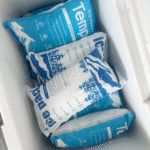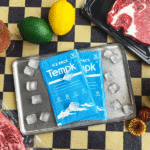Introduction:
Dans le monde logistique en évolution rapide d’aujourd’hui, ensuring that temperature-sensitive goods like pharmaceuticals, nourriture, and biotech products are kept within precise temperature ranges is crucial. Traditional dry ice is slowly being replaced by innovative solutions, tel que ice substitute dry ice packs, which offer several advantages. These packs are particularly important for industries requiring strict temperature control, providing an efficient and safe way to transport goods. Dans cet article, nous explorerons les avantages, applications, and trends shaping the use of ice substitute dry ice packs in 2025 et au-delà.
-
How do ice substitute dry ice packs work?
-
Which industries benefit most from using these ice packs?
-
How can you choose the right ice substitute dry ice pack for your needs?
-
What are the cost implications and environmental benefits of these packs?
How Do Ice Substitute Dry Ice Packs Work?
Ice substitute dry ice packs are designed to provide effective cooling without the risks associated with traditional dry ice. These packs use Matériaux à changement de phase (PCMS) ou gel-based substances that absorb and release heat at specific temperatures. Contrairement à la glace sèche, which sublimates and creates carbon dioxide gas, ice substitute packs maintain cold temperatures through a more stable, non-hazardous process.
Core Mechanism: When the phase change material inside these packs changes state (from solid to liquid or vice versa), it absorbs or releases large amounts of energy, keeping the surrounding products at a stable temperature. This ability makes them particularly useful for transporting pharmaceuticals, vaccins, et marchandises périssables.
Key Components of Ice Substitute Dry Ice Packs:
-
Couche d'isolation: Minimise le transfert de chaleur, ensuring that the cooling effect is prolonged.
-
Phase Change Core (Dry Ice Equivalent): The cooling mechanism, responsible for absorbing heat and maintaining the required temperature.
-
Protective Outer Shell: Durable, lightweight materials that protect the contents during transit, ensuring the pack remains intact.
| Composant | Description | Importance |
|---|---|---|
| Couche d'isolation | Reduces external heat transfer | Prolongs cooling effect |
| Phase Change Core | Absorbs and releases heat at specific temperatures | Maintains consistent temperature |
| Protective Outer Shell | Léger et durable | Enhances safety and ease of transport |
What Industries Benefit the Most from Ice Substitute Dry Ice Packs?
Ice substitute dry ice packs are crucial for industries that rely on temperature-sensitive products during transit. Some of the industries that benefit the most include:
Médicaments:
-
These packs are essential for transporting drugs, vaccins, et les biologiques, which require precise temperature control to remain effective.
Nourriture et boisson:
-
Ensuring freshness of perishable goods such as meats, laitier, and frozen foods is vital. These packs ensure that food products stay fresh from the manufacturer to the end customer.
Biotechnologie:
-
Many biotech products, like biological samples, need to be transported at strict temperature ranges to maintain their integrity. Ice substitute dry ice packs help preserve these materials.
How to Choose the Right Ice Substitute Dry Ice Pack for Your Shipment?
Choosing the right ice substitute dry ice pack involves understanding the nature of the goods being shipped, la plage de température requise, et la durée de l'envoi. Here are some key considerations when selecting the right pack:
1. Exigences de température:
-
Ice substitute packs can be tailored to maintain specific temperature ranges, généralement entre 2°C et -20°C, depending on the material inside.
2. Durée du refroidissement:
-
Consider how long the shipment will take. Pour des durées plus longues, you may need larger or more robust packs that offer longer cooling durations, typiquement 12 à 48 heures.
3. Taille et ajustement:
-
The size and shape of the pack should fit within the designated shipping containers, ensuring optimal performance and no space wastage.
Conseil: Always run a test before full-scale use to ensure the chosen pack meets your cooling needs under real-world conditions.
Cost Implications and Environmental Benefits of Using Ice Substitute Dry Ice Packs
While the upfront cost of ice substitute dry ice packs may be higher than traditional ice, their long-term savings and environmental benefits make them a worthwhile investment.
Cost Factors:
-
Dégradation réduite: En maintenant des températures constantes, these packs help reduce product spoilage, saving businesses money by minimizing waste.
-
Better Compliance: Industries with strict temperature control regulations, comme les produits pharmaceutiques, can avoid costly penalties by using these packs to stay compliant.
-
Amélioration de la satisfaction du client: By ensuring that products arrive in optimal condition, businesses can enhance customer loyalty and build a reputation for reliability.
| Facteur de coût | Avantage | Impact sur votre entreprise |
|---|---|---|
| Dégradation réduite | Moins de déchets, fewer damaged goods | Des marges bénéficiaires plus élevées |
| Coûts de conformité | Avoid regulatory fines | Maintains reputation and trust |
| Satisfaction client | De haute qualité, safe delivery | Increased customer loyalty |
Avantages environnementaux:
-
Conception écologique: Many ice substitute dry ice packs are réutilisable and made from Matériaux biodégradables, making them a durable choice.
-
Empreinte carbone réduite: Contrairement à la glace sèche, which produces CO₂ emissions when it sublimates, these packs help businesses meet objectifs de durabilité while still offering effective temperature control.
2025 Trends in Ice Substitute Dry Ice Packs
Innovation in Materials:
La demande de écologique solutions in cold chain logistics is pushing manufacturers to develop matériaux durables for ice substitute dry ice packs. These materials improve thermal insulation while minimizing environmental impact, making them an attractive choice for businesses looking to reduce their carbon footprint.
Integration of Smart Technology:
Advances in technology are also being integrated into these packs. Capteurs intelligents are now being used in some packs to provide surveillance de la température en temps réel, alerting users if temperatures deviate from the desired range. This helps reduce the risk of spoilage and improves shipment reliability.
Questions fréquemment posées
Q1: How long do ice substitute dry ice packs last?
Typiquement, ice substitute dry ice packs last 12 à 48 heures, en fonction de la taille de l'emballage et des conditions environnementales.
Q2: Can I use ice substitute dry ice packs for shipping food?
Oui, these packs are ideal for shipping temperature-sensitive foods, such as frozen items, laitier, et la viande, ensuring that they remain fresh during transit.
Q3: What makes ice substitute dry ice packs better than traditional dry ice?
Ice substitute packs offer longer-lasting cold, non-hazardous handling, et un impact environnemental réduit, making them a superior alternative to traditional dry ice.
Conclusion et recommandations
Ice substitute dry ice packs are transforming cold chain logistics by providing a safer, plus efficace, and cost-effective way to transport temperature-sensitive products. By selecting the right pack based on your shipment’s requirements, you can improve efficiency, réduire la détérioration, and enhance compliance.
Étapes suivantes:
Evaluate your current cold chain logistics processes and consider integrating ice substitute dry ice packs into your operations for improved product safety and operational efficiency.
À propos du tempk
À Rotation, we specialize in offering industry-leading cold chain solutions. Our ice substitute dry ice packs are designed for maximum performance et durabilité, ensuring your temperature-sensitive goods stay safe during transit. We offer tailored solutions to meet your logistics needs with a focus on innovation et fiabilité.
Contactez Tempk dès aujourd'hui to learn more about how our ice substitute dry ice packs can enhance your shipping operations.






















